|
Posted in category "Celebrities"
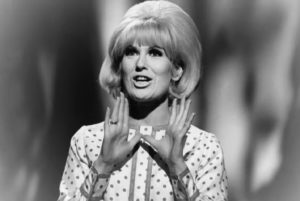
I had the Sirius station tuned to the 60s channel when Dusty Springfield’s song, “I Only Want to Be With You” came on. “I don’t know what it is that makes me love you so,” she sings. “I only know I never want to let you go. ‘Cause you started something, oh, can’t you see? That ever since we met you’ve had a hold on me. It happens to be true, I only want to be with you.” I remembered during the song that Dusty Springfield was supposed to be bisexual; “Son of a Preacher Man” was another one of her big hits. When I got home I decided to google Dusty Springfield and see what became of her. Not only was Dusty Springfield not bisexual—she was a lesbian—she was in the midst of a torrid affair with a woman in Memphis when she recorded “Son of a Preacher Man.” Dusty Springfield was one of the most successful female British singers of the 1960s, with a half dozen singles in the top 20. “You Don’t Have to Say You Love Me,” (1966) was her biggest hit in the U.S. and the U.K.
“There is a sadness there in my voice. I was born with it. Sort of melancholy. Comes with being Irish-Scottish. Melancholy and mad at the same time.” – Dusty Springfield
“My sexuality has never been a problem to me but I think it has been for other people.” – Dusty Springfield
EARLY DAYS
Dusty Springfield was born Mary Catherine Isabel Bernadette O’Brien in London, England on April 16, 1939. Her mother was Irish and her father was Scots-Irish. She was a tomboy growing up, and given the name “Dusty” playing football (soccer) with the boys. She attended an all-girls school, St. Anne’s Convent School in Enfield, London. The nuns predicted that the shy girl was going to become a librarian. As a teen, Dusty had short auburn hair and glasses. She credited the school with her first “blues” performance during a school assembly. After she left at 16, Mary O’Brien recreated herself as “Dusty Springfield,” a glamorous blond with make-up, teased hair and mod outfits.
In the early years of her career Dusty remained a practicing Catholic. The tour bus stopped so she could go to confession or attend Mass. But as the Sixties progressed, the practice of her faith diminished, and she began her long struggle with alcohol, self-harm, and violence in her relationships. She was eventually diagnosed as suffering from bipolar disorder in addition to alcoholism. 
Growing up, Dusty knew she was attracted to girls. Her first crush was on one of the nuns. She told Sue Cameron, one of her lovers, that she would watch a girl who lived across the street get undressed in front of the window. Her discovery of her lesbianism led to internal conflicts with her Irish Catholic upbringing, which she never resolved. Most Catholic lesbians and gays could not reconcile their sexuality and faith in the 1960s, and it is still a struggle today. To be one, we had to hide the other. This lack of authenticity and wholeness affected every part of Dusty’s life. Her inability to talk about that part of herself and her relationships produced terrible conflict and pain. For many years she managed it by drinking, drug use, and transient affairs and relationships, and the ever-present cloud of guilt and shame.
CAREER SUCCESS
Dusty had her first woman lover in 1963. In early 1964, her career took off with her first hit single, “I Only Want to Be With You.” Her desire for other women was forbidden in Britain at that time, so like most lesbian and gay artists, she performed for the straight majority but with emotions that were directed to her female partners and pursuits. During her peak, Dusty Springfield ranked among the most successful female performers on both sides of the Atlantic. Her blonde, bouffant hairstyle, heavy eye makeup, evening gowns, and stylized hand gestures, made her an icon of the Swinging Sixties.
She was in the limelight throughout the 1960s with such hits as “I Only Want to Be With You” (1964); “I Just Don’t Know What to Do With Myself” (1964), “You Don’t Have to Say You Love Me” (1965), “All I See is You” (1966), “The Look of Love” (1967), “Breakfast in Bed” (1969) and Son of a Preacher Man (1969). At the same time, Dusty was terrified that her lesbian love life would come to light and her career would be ruined. She also worried about its impact on family, friends and fans. Dusty Springfield hid her lesbianism for years, and used her Catholic upbringing as an excuse: “You have to concentrate on marriage and I’m a Catholic and can’t get divorced,” she said. Dusty was never reported to be in a relationship with a man. 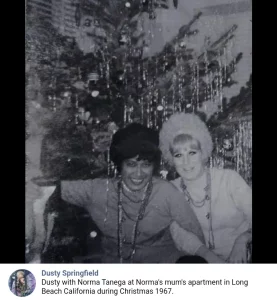
PARADE OF LOVERS
Dusty started churning through women beginning in the mid-sixties. In 1966 Springfield met American singer Norma Tanega, a Mexican-American singer, painter and activist. The couple fought just as hard as they loved. “I can’t tell you how many times I got that phone call at three in the morning,” said one of Dusty’s friends. “Get over here, Cat’s trying to kill me!” (Cat was Norma’s pet name for Dusty). Or, “John, come quick, Norma’s trying to kill me!” Dusty was prone to having flings behind Norma’s back. “I don’t mean that I leap into bed with someone special every night, but my affections are easily swayed and I can be very unfaithful. It’s fun while it’s happening, but it’s not fun afterwards because I’m filled with self-recriminations. The truth is I’m just very easily flattered by people’s attentions, and after a couple of vodkas I’m even more flattered.” She added, “I suppose to say I’m promiscuous is a bit of bravado on my part. I think it’s more thought than action. I’ve been that way ever since I discovered the meaning of the word. I used to go to confession and tell all my impure thoughts.”
Norma Tanega left Dusty in the early 70s when she found their relationship too difficult to sustain. According to Tanega, Dusty “wanted to be straight and she wanted to be a good Catholic, and she wanted to be black.” Springfield owned that while she was brought up Catholic, she no longer went to Mass. “It’s about six years since I made my Easter Duties. My mother’s going to love this. I still think that because I don’t go to Confession I’m going to go to hell but I haven’t done anything evil. I’m just lazy and self-indulgent.”
After Norma, Dusty began a string of on and off relationships, short affairs and one-night stands. From 1972-1978, she saw Faye Harris, an American photojournalist. In the 70s she was linked to the tennis pro Rosie Casals, although Casey’s said they were close friends, not lovers. There was a woman in Australia that shoved Dusty into a hotel fountain during a fight. In 1968, while recording her masterpiece album, “Dusty in Memphis,” she had a torrid affair with a woman named Sandy, drinking and partying so hard that she lost her voice. During the same trip, Dusty got into a fight with Sandy or another woman, which ended up with a TV in the hotel’s swimming pool at 4 am. One of them had picked up the TV and thrown it at the other. It went out the window and down 14 floors into the pool. One woman called the police on Dusty saying she had drugs. “As it happens I know who tipped them off,” she said. “There was a rather hysterical lady who was upset because I didn’t fancy her.”
In 1970 she gave an extremely brave interview to Ray Connolly in London’s Evening Standard, talking about her rumored attraction to women. “There’s one thing that’s always annoyed me, and I’m going to get into something nasty here. But I’ve got to say it because so many people say it to my face. A lot of people say I’m bent, and I’ve heard it so many times that I’ve almost learned to accept it. I don’t go leaping around to all the gay clubs but I can be very flattered. Girls run after me a lot and it doesn’t upset me. It upsets me when people insinuate things that aren’t true. I couldn’t stand to be thought of as a big butch lady. But I know I am perfectly capable of being swayed by a girl as by a boy. More and more people feel that way and I don’t see why I shouldn’t.”
THE OBSCURE YEARS
Dusty Springfield’s honesty came at a price— her popularity waned and she didn’t have a hit single for another 15 years. By the early 70s her stardom was over, and during the next decade and a half she faded into obscurity in LA as her fortune and career ebbed away. In 1972, Dusty had decided to flee the English press and move to California. The move left her short of money and without the support network she had in London. Her alcohol and drug use increased, and she found herself caught in an alcoholic haze that’s still too familiar to lesbians and gays torn between the closet and the need to live honestly. “When I knew Dusty, unfortunately, she was a mess,” said a lesbian business owner in LA who had a brief affair with her. “She was a very fragile, brilliant, special person—the sweetest, nicest person you could ever know. But she was also the most insecure person who ever lived. She was drinking, using, and slitting her wrists. She was so vulnerable.”
In the mid-seventies Dusty plucked up the courage to tell her parents that she was a lesbian—only to have it dismissed as unimportant or a joke. She was devastated by their reaction not to take her seriously. By then, her drug use was out of control, her love life reduced to a string of short-lived affairs, the sales from her recordings were low, and her royalties reduced to a trickle. She was often between stays in rehabs and hospitals. But she had yet to reach her lowest point.
 Dusty and Sue Cameron DEMONS, DRUGS AND ALCOHOLISM
In 1974, Springfield’s mother passed away. This brought her to a deep mental low. Her lover, Sue Cameron, said that Springfield would sit on the floor and hallucinate about demons. “She would scream a lot,” Cameron said. “She’s say, “Demons! Demons! They’re coming to get me! – over and over again. “She’d also threaten to harm herself. She said when she cut herself she knew she was alive, because she could feel it.” A succession of psychiatrists confirmed that Dusty was struggling not only with alcoholism but also mental illness; depression and bipolar disorder. She also attempted suicide multiple times. Cameron ended her relationship with Springfield when Dusty chased her with a knife. “I will never know whether she intended to hurt me or not,” Cameron said. “She was laughing at my terror as she came toward me, teasing me by thrusting the knife closer and closer as I backed up. In my heart I think she was playing a sick game that was almost out of her control. I ran out of there to save myself.”
In 1981, Dusty met Carole Pope of Rough Trade, a Toronto-based rock band known for their provocative lyrics. Their 1981 hit, “High School Confidential,” was one of the first explicitly lesbian-themed Top 40 hits in the world.
“She’s a cool blonde scheming bitch, She makes my body twitch. Walking down the corridor. What’s her perfume? Tigress by Faberge. She makes me cream my jeans when she comes my way.”
In 2000, Random House published Pope’s autobiography, Anti Diva. The book detailed Pope’s relationship with Springfield, how they met and first had sex. “My manager, Vicki Wickham, thought that Dusty and I should meet. I heard stories Vicki told about Dusty, and she sounded like a handful, but Vicki believed that you could have any woman you wanted if you put your mind to it. Her mantra, “Every Bird is pullable,” had become part of my philosophy. So, in the fall of 1980 I flew to New York to meet the Queen of the Mods and see her perform at a supper club called the Grand Finale. Vickie came with me. The place was packed with Dusty fanatics and celebs; the audience included Rock Hudson and Helen Reddy, the singer of “I am Woman.”
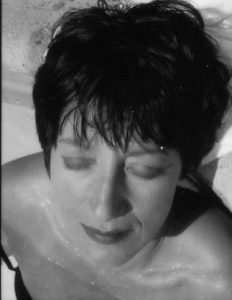 Carol Pope “My first words were, “Vicki suggested we meet.” Dusty looked at my shyly and smiled. We started to talk and joke around, and within minutes were flirting madly with each other. In the middle of our dance of seduction, Helen Reddy came backstage with her husband. Dusty and I turned to each other and said, after they left, “Why is she married? She seems like a big dyke.”
Some months later, Dusty invited Carol to see her at the Montreal Ritz-Carlton. “I tentatively knocked on the door of Dusty’s suite. She answered, then stepped back into a rococo décor accented with heavy black and gold wallpaper. She seemed shy and unsure, and she was not alone. Her assistant—a girl draped in peals who epitomized the meaning of the word preppy—was introduced as Westchester. She discreetly left the room. Yes, the air was thick with sexual tension. She offered me a drink, and the next thing I knew we were all over each other. We tumbled into bed, half-naked. It was the first time I’d been with an older woman. Dusty had several years on me, and I found the idea very erotic. I fixated on her sensual mouth and unfathomable eyes. The most erotic thing we ever did in bed was this: I would beg Dusty to sing to me. She would put her mouth up to my ear. Then the sound of her voice, so intimate and so close, would wash over me in waves of pure pleasure.
Carol Pope asked Dusty to sing background vocals on a song, “The Sacred and the Profane,” she wrote for Rough Trade’s 1981 album, “For Those Who Think Young.” “Under the influence of Dusty—my twisted Catholic girl—my brain was inundated with images of Fellini films and Catholic morality.”
The hairdresser teaser her coif
With his tail comb
She has the tortured look of a Magnani
Constantly hounded by the paparazzi
The blood of Rome runs through her veins
She’s frightened by her overactive hormones
Mondo Italiano La Dolce Vita
Lust is written all over her face
She loves the smell of danger…
The fury of fallen angels
The aspirations of saints
The sacred and the profane
The relationship between the two started to erode the first time Carol had to take Dusty to the emergency room. “Dusty had taken some pills, coke, and God knows what else.” Carol took the knife out of Dusty’s hands when she started to cut her arms. “I tried to ignore the faded scars on her arms…What kind of self-loathing drove her to it?…Dusty was mainly silent about her past and the origin of her demons.”
“We broke up in LA. I told her I was being torn apart by her behavior. She was lost and I cared deeply about her, but she was fucking up my life. Dusty was very sweet, and resigned to the outcome. A few months before she died, Dusty called Carol to apologize. “She said, “I’m sorry for the way I behaved when we were together. You know I loved you.”
Dusty started to attend Alcoholics Anonymous meetings to help her deal with her drinking. She met actress Teda Bracci at an AA meeting in 1982 and they moved in together in April 1983. Bracci recalled that during a trip to Rome Dusty kissed her on a balcony overlooking the Vatican in defiance of her faith. 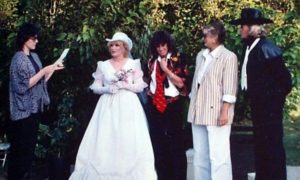
The two women wed at the end of 1983, exchanging vows in a backyard ceremony in LA’s San Fernando Valley. A lanky and vivacious brunette, Bracci appeared in some action films: a biker chick in CC & Company with Joe Namath and Ann Margaret; a prison inmate in a few episodes of Falcon Crest, a popular TV soap opera; a female lead in the LA premiere of Hair; and headlined in famous Sunset Strip rock clubs like The Troubadour and the Whiskey-A-Go-Go. The “best lady” at the wedding ceremony said Dusty wore a formal wedding gown, and the other bride wore a pants outfit with a vest and tie. Dusty was trying to stay sober, so anyone who wanted a drink would need to retrieve a bottle of Jack Daniels that hung from a rope outside the bathroom window. “Everyone seemed happy and peaceful that day,” the best lady said.
But like her other relationships, her marriage to Bracci quickly deteriorated into drunken violence. In one incident, Dusty menaced Bracci with a broken cup and slashed her leg. Bracci responded by hitting Dusty repeatedly in the head with a boot.
The last straw came on a day when Dusty was drinking wine and taking Valium. Teda returned to their apartment and the inevitable fight ensued. Bracci hit Springfield in the mouth with a saucepan and her teeth were knocked out. A plastic surgeon was able to patch her up, but damage to her face was permanent. The couple separated, and by 1987 Dusty headed back to Britain and a revival of her musical career.
BREAST CANCER
Dusty recorded several songs with the Pet Shop Boys, including the hits, “What Have I Done to Deserve This,” (1987) and “Nothing Has Been Proved,” (1988). In 1994, during work on her last album, “A Very Fine Love,” Dusty discovered she had breast cancer. Although her initial treatment was successful, the cancer returned and she died on March 2, 1999, in Henley-on-Thames, Oxfordshire, one month short of her 60th birthday. She had a Catholic funeral Mass in St. Mary the Virgin Church. Her casket was brought to the church by a horse-drawn carriage as she requested, and “You Don’t Have to Say You Love Me” was playing as her casket was carried into the church. Hundreds of fans and people from the music business attended her funeral, including ex-lover, Carol Pope.
In her last interview with the New York Times, Dusty said she would be very happy if her life took her back to Ireland. Her brother Tom, honored her wish and scattered a portion of her ashes near her favorite spot, the Cliffs of Moher. The rest of her ashes are buried under a granite marker in St. Mary the Virgin churchyard in Henley.
In the months before her death, Dusty reflected on her life with two of her friends. Lee Everett-Akin was the widow of gay DJ Kenny Everett. Like Dusty, he was raised Catholic, and that formation stayed with him throughout his life. “Being “outed” was one of her greatest fears. She just felt that she would be rejected by everyone if her secret came out. “We had a great affinity around her sexuality because Kenny felt exactly the same way. He was terrified of people finding out. They were very similar people, in that they were both brought up strict Catholics and that brought with it an awful lot of guilt.” Lee added that one of Dusty’s biggest regrets toward the end of her life was that she never settled down with someone. “She had so much love to give, even though she knew she was impossible to live with. She would say, “My life would’ve been so different if I’d had a good relationship.” Lee Everett-Akin had tried to persuade Dusty to write her life story, but Dusty told her she couldn’t remember most of it because of drugs and drinking. “The saddest thing of all,” Everett-Akin said, “was that when she was dying she told me she was embarrassed by her life, by the drinking, the failed relationships. She felt she had made so many mistakes in her life.”
Lee Everett-Akin’s comments echoed those of another close Dusty friend, Simon Bell, who moved in with her for the last 14 months of her life. “There were certain things she was addicted to, like the drink and the drugs and indeed relationships, that she eventually learned she just couldn’t have, said Bell. “She was never totally comfortable with the fact that she was a lesbian. She was very open privately with me but I think her Catholic background stayed with her right to the end and she never completely came to terms with it.”
MY LANGAN LOVE
The anger and the sadness of being a gay or lesbian Catholic always remains. Allies in local parishes, sympathetic clergy, and the large poll numbers of Catholics who believe their LGBT brethren should be treated fairly and respectfully encourage our belief that we truly belong; but the words we heard growing up and as young adults—that we were sick, our desires were twisted, that God, Jesus and the Church were against us—still resonate in our memories and emotions.
Despite all the negativity and doubt, there are times when we feel at home—with a place, in a song, with ourselves. In a YouTube video search of Dusty singing, I chanced on a clip of her performing “My Lagan Love” during a 1967 TV show. It is an old Irish ballad. “People get the idea,” she starts, “that all Irish songs are either “Paddy McGinty’s Goat” or “When Irish Eyes are Smiling,” all those lovely sorts of Hollywood Irish songs. Actually, the most beautiful ones I’ve ever heard are played by a very old gentleman somewhere in Donegal…The song that impressed me most of all was the one I’m going to attempt to sing for you now, called My Lagan Love.” A harper accompanied Dusty, who played an acoustic guitar. 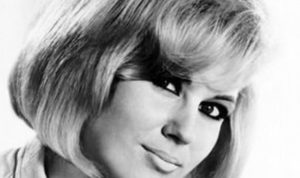
My Lagan Love
Where Lagan streams sing lullabies
There blows a lily fair.
The twilight gleam is in her eye,
The night is on her hair.
And like a lovesick Lennan-shee
She hath my heart in thrall.
No life have I, no liberty,
For Love is Lord of all.
And often when the beetles horn
Has lulled the eve to sleep
I’ll steal into her shelling lorn
And through the doorway creep.
There on the cricket’s singing stone,
She makes the boxwood fire
And sings in sweet and undertone
The song of hearts desire.
Her welcome, like her love for me,
Is from her heart within.
Her warm kiss is felicity
That knows no taint of sin.
And when I stir my foot to go,
‘It’s leaving Love and light,
To feel the wind of longing blow
From out the dark of night.
Dusty’s performance was shy and humble, which made her rendition of the song even more piercingly beautiful. The verses of anticipation, desire, love and longing were authentic; not the covert references to love in her Top 40 hits. Dusty was fully at home and in peace in the love song, and it was beautiful to hear, see and experience.
On March 1, 1967, New Orleans businessman Clay Shaw, 54, was arrested at his home on 1313 Dauphine Street on charges that he conspired to assassinate President John F. Kennedy. New Orleans District Attorney Jim Garrison said Shaw conspired with Lee Harvey Oswald, David Ferrie and Guy Bannister to kill Kennedy. Lee Harvey Oswald, a former U.S. Marine, shot Kennedy on November 22, 1963, from a sixth-floor window of the Texas School Depository as Kennedy traveled by motorcade through Dallas. Shot through the head, he died almost instantly. Garrison claimed that Shaw was the man named as “Clay Bertrand” in the Warren Commission Report. Garrison said that Shaw used the alias Clay Bertrand in New Orleans’ gay circles. 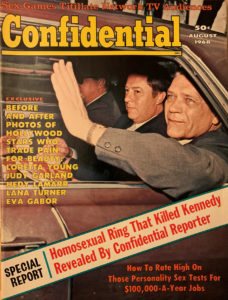
Conspirators
Guy Bannister was a private investigator in New Orleans. He was a former FBI agent and an avid anti-communist, with ties to various anti-Castro groups. David Ferrie, a former seminarian, was an airline pilot and an anti-communist activist. At the time of the assassination Guy Bannister was helping Ferrie in his dispute with Eastern Airlines and the New Orleans Police Department regarding charges of extortion and “crimes against nature”—picking up teenage boys for sex.
Homosexual Thrill Killing
Like many Americans, New Orleans District Attorney Garrison did not believe that Lee Harvey Oswald acted alone but was part of a conspiracy to kill Kennedy. Since Garrison needed a theory that allowed him the authority to prosecute, he produced the idea that the assassination was a “homosexual thrill killing.” Since gay men were culturally perceived as criminal sexual deviants, they were vulnerable to blackmail and intimidation. On July 15, 1967, NBC gave Garrison a full half hour to explain his hypothesis about the assassination. “Tonight, I’m going to talk to you about truth and about fairy tales,” he began. Garrison told journalist James Phelan of the Saturday Evening Post that David Ferrie and Clay Shaw “had the same motive as Loeb and Leopold, when they murdered Bobbie Franks in Chicago back in the twenties,” a reference to the sensational 1924 kidnapping and murder of a fourteen-year-old boy by two lovers.
Fabricating a Theory
Garrison’s spider web of conspirators were connected by gossamer threads. Shaw and Ferrie were both homosexuals. Ferrie and Garrison were anti-Communists associated with Cuban refugees in anti-Castro groups. Lee Harvey Oswald joined a civil air patrol squadron in 1955. Oswald met Ferrie when he was a guest instructor. Under hypnosis, Perry Raymond Russo, an insurance agent, claimed that he saw Shaw, Oswald and Ferrie at a party discussing assassinating President Kennedy. The conversation also included plans for “triangulation of crossfire” and alibis for the participants. 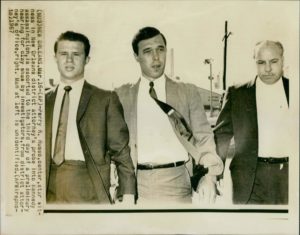
Russo recalled seeing Shaw on Nashville Avenue Wharf when he went to see JFK speak (May 4, 1962). “He said he particularly remembers this guy because he was apparently a queer. It seems that instead of looking at JFK speak, Shaw kept turning around and looking at all the young boys in the crowd. He said that Shaw eventually struck up a conversation with a young kid not too far from him. It was perfectly obvious to him that Shaw had stared at his penis several times…He said that Shaw had on dark pants that day that fit very tightly and were the kind of pants that lots of queers in the French Quarter wear.” During the trial a prosecutor asked Shaw and various witnesses if Shaw had ever worn “tight pants.” Shaw said that he didn’t have any tight pants.
Like Shaw and Ferrie, Russo was a homosexual. Russo was Garrison’s star witness at Shaw’s trial. In 1971, he admitted to members of Shaw’s defense team his story was completely made up, and he persisted with it since he was afraid of Garrison and would not “sacrifice himself” for Shaw.
Clay LaVergne Shaw was big man, six foot four and a barrel-chested 225 pounds. Quiet and soft-spoken, he moved in New Orleans’ elite social circles. Shaw was the former head of New Orleans’ International Trade Mart. He was an amateur playwright (Tennessee Williams was a friend). Shaw was also an advocate of restoring the city’s famed French Quarter, where he owned a home. His close friends knew that he was gay, but it was a carefully guarded secret so it would not affect his standing in the community.
Continuing Harassment
The jury took less than an hour of deliberation to return with a verdict of not guilty. The date was March 1, 1969, exactly two years after his arrest. A few days after his acquittal, Garrison charged Shaw with perjury. Shaw spent the remaining years of his life and his entire savings trying to clear his name. The strain of the five-year ordeal took its toll on Shaw’s health. He died of lung cancer on August 14, 1974. He was 61 years old.
Garrison’s group of conspirators eventually morphed beyond Lee Harvey Oswald (who was insinuated to be gay or bisexual) and a few gay men in New Orleans. His theory went on to include the FBI, CIA and the whole “Military-Industrial Complex” of plotting Kennedy’s death in cahoots with anti-communist and anti-Castro extremists. Despite the bizarre circus of Shaw’s trial, Garrison managed to keep Kennedy assassination conspiracy theories in public consciousness.
Although Clay Shaw was discreet about his homosexuality, Garrison knew about it and found it useful to portray Shaw as a criminal and a conspirator. Shaw’s “double life” fed into that narrative. How Shaw managed his gay circle and sexual life during the trial is sad, showing a blameless and dignified man turning on himself at his core. During the trial and aftermath, he must have endured an excruciating amount of ridicule and prurient interest. Shaw wanted to protect his friends, so he told them to stop contacting him directly. He also sought counseling with a Catholic priest and began reading extensively about spirituality, including Father Adrian Van Kamm’s Religion and Personality. Another book was Thomas Merton’s, Conjectures of a Guilty Bystander, which Shaw mistitled, Confessions of a Guilty Bystander in his journal and an interview.
Homophobia
Author Alecia P. Long, in her 2021 book, Cruising for Conspirators – How a New Orleans DA Prosecuted the Kennedy Assassination as a Sex Crime, includes a short vignette on pages 120-121 on Shaw’s struggle with his sexual desires. “On April 17 Shaw documented in his journal a daylong struggle with sexual temptation. ‘I have resolved, since all this happened, to change my life completely and to let die certain aspects of my personality which should have been disposed of many years ago.’ The sexual attraction he felt awakened “memories, reflections, and desires” that he found “vivid, intense and disturbing.” “At day’s end, he wrote, ‘The best defense seemed to be silent repetition of the Lord’s prayer off and on during the day, with particular emphasis on that passage asking that we be led not into temptation but delivered from evil…Empirically, it worked. By afternoon all temptation had disappeared. I have no hope it will be that easy in the future, but at least I have found the path.”
Homophobia – never mentioned – played a huge role in Garrison’s conspiracy theory, the trial, and Shaw’s individual reckoning. Shaw fought to clear his name as an assassination conspirator until the end of his life, but in the process of doing so seems to have come to believe that his homosexuality was responsible for his predicament. He committed to celibacy to make amends. What an ugly and mournful end for a man who lived as fully, productively and authentically as society would allow until he was falsely accused of killing Kennedy.
Andy Warhol is an influential and celebrated 20th century artist and pop icon. He was gay and was raised Catholic. His faith and sexuality influenced his art. As an adult, he did attend church from time to time, especially after he was shot and almost killed in 1968 by Valerie Solanas, a writer and radical feminist.
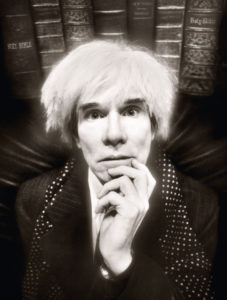 Andy Warhol with Bibles “Revelation” an exhibit at the Brooklyn Museum from November 19, 2021 to June 19, 2022, features Warhol artworks that are infused with both strains, often harmoniously and deeply revealing. The show was developed by the Andy Warhol Museum’s chief curator, Jose Carlos Diaz and curated at the Brooklyn Museum by Carmen Hermo.
Some of the show’s highlights include Warhol’s two gigantic versions of “The Last Supper” in pink and yellow; and a fusion of the face of Christ, an advertising tagline, and a shirtless young man; and a shot-up, scarred Warhol reminiscent of Christ’s wounds or a martyred St. Sebastian.
Much of Catholic dogma, art and religious expression is focused on the body. The sacrament of the Eucharist—eating and drinking Christ’s body—can have sexual overtones. Human figures in Catholic art history are often beautiful men, some in sexually suggestive poses. These influences went into Warhol’s formation as an artist and as a man, and he combined them with the pop arts trends of the day. Catholicism has inspired generations of homosexual artists through its sensual and sexually charged imagery. 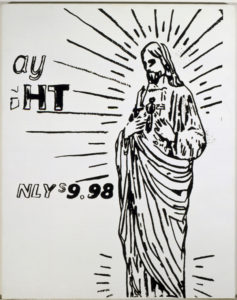
 John Wojtowicz “I’m a Catholic and I don’t want to hurt anybody. Understand!” yelled Sonny Wortzik, the bank robber played by Al Pacino in the memorable 1975 movie, Dog Day Afternoon. Pacino’s character was based on John Mojtowicz, 27, who along with 18-year-old Salvatore Naturile, and Robert Westenberg, attempted to rob a Chase Manhattan branch in Gravesend, Brooklyn on August 22, 1972. Westenberg fled when he saw a police car. All three men were gay. The night before the robbery they all had sex together at the Golden Nugget Motel.
In the movie, the main reason for the heist was to get money to pay for a male-to-female sex change operation for John Wojtowicz’s wife. That may have been part of Wojtowicz’s stated reason, but was it the whole truth? According to Liz Eden (born Ernest Aron), Wojtowicz’s transgender wife, Wojtowicz owed the Gambino family money. Some of that money went to pay for their December 1971 wedding, where they were married by a Roman Catholic priest. Liz Eden wore a wedding gown; John Wojtowicz his Army uniform and medals from the Vietnam war.
According to the FBI, Wojtowicz met Naturile a month prior to the robbery at a gay bar called Danny’s, located on Seventh Avenue South in the Village. Naturile agreed to participate to get money to rescue his two sisters from foster care. The guns used in the robbery supposedly came from Mike Umbers, 37, a Gambino family associate who ran a club, bar and bookstore in the West Village. Umbers fronted several gay bars, callboy rings and pornography operations for the Genovese and Gambino organized crime families. Wojtowicz was friendly with Umbers, much to the chagrin of his fellow Gay Activist Alliance (GAA) members. Wojtowicz was known as “Littlejohn Basso” (Basso was his mother’s maiden name) at GAA.
 Sal Naturile On August 26, 1972, this article about Wojtowicz’s Brooklyn heist appeared in the New York Times:
“An acquaintance of John Wojtowicz—who has been charged with robbing a Chase Manhattan branch in Brooklyn last Tuesday and holding nine persons hostage—reportedly told the Federal Bureau of Investigation yesterday that an underworld figure supplied the guns used by Wojtowicz and two accomplices in the holdup.” “The acquaintance, Gary Badger, was questioned by F.B.I. agents yesterday afternoon, but the bureau would not comment. A friend of Mr. Badger, however, said that he told the agents that five men, including Wojtowicz, began planning the robbery last April, but that two of the men later bowed out. Wojtowicz was pressed to carry out the robbery by the underworld figure, who owns Greenwich Village bars and is involved in pornography, Mr. Badger reportedly told the agents. Mr. Wojtowicz owed the gangster money, he said.” Arthur Bell, a respected Village Voice columnist and investigative reporter, interviewed Badger, who showed up at a GAA meeting to make a plea for money to help bury his friend, Sal Naturile.
Arthur Bell knew Wojtowicz through GAA meetings and dances. He interviewed Wojtowicz and published an article about the robbery in the August 31, 1972 edition of the Village Voice, “Littlejohn and The Mob, Saga of a Heist.” Wojtowicz described how he met a middle-aged Chase Manhattan bank executive at Danny’s. The executive told him how he could rob the branch of $150,000 to $200,000. The money in the bank’s safe was picked up early; so instead of the big payday only $29,000 was on hand.
Bell also knew Mike Umbers, and interviewed him in 1971, a year before the robbery. The article, “Mike Umbers: Christopher’s Emperor,” described his start in the sex business; first as a pimp for high-class call girls and brothels, and then catering to gay men. Umbers had his run-ins with police and other crime families. According to the article, “Corruption, Before and After Stonewall,” Mike Umber’s Christopher’s End club was trashed by police. It was possible that police destroyed the interior with hammers and axes because Umbers wasn’t paying them off; or, the attack was ordered by Al Moss, also known as Abe Moss, who ran some gay bars for the Gallo crime family in the West Village.
 Mike Umbers (second from right) in front of Christopher’s End I was interested to read that Al Moss had a nephew named “Red” who paid the police $2,000 a month to protect The Barn, an after-hours club on Hudson Street. “Red” may be a reference to Red Mahoney, a long-time associate of Ed Murphy, who had his own checkered past as a gay blackmailer and gay activist. Mahoney worked with Murphy when he was alive and took over running the Christopher Street Festival after Ed died in 1989. Mahoney ran the Festival until 1992, when he became ill and stepped down. Mahony was a short, grumpy guy with dark red hair. He didn’t have Ed Murphy’s gregarious nature or command the same respect.
The vast web of connections between the mob (Genovese, Gambino, Gallo crime families), their associates (Murphy, Mahoney, NYPD), front men (Umbers), expendables (Wojtowicz, gay hustlers) and gay clubs and bars before and after Stonewall continues to amaze me. The connections were essential to their multi-million dollar businesses of bars, clubs, pornography, prostitution and blackmail.
Was the middle-aged Chase Manhattan executive who tipped off Umbers and Wojtowicz being blackmailed?
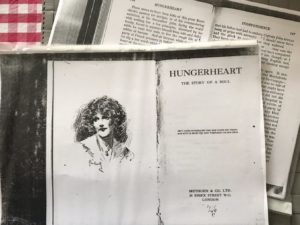
Hungerheart is a lesbian novel written by British author Christabel Marshall under her adopted male name, Christopher St. John. The book was published in 1915 in London by Methuen & Co. The novel is a first-person account of Joanna, “John” Montolivet that follows her search for love and passion. At one point she lives with Sally, a young actress, and they are “happy as a newly married pair, perhaps happier…” Sally decides to marry a man, and Joanna/John finds solace in the arms and bodies of stormy and dramatic women. Eventually she heads for quieter shores, and coverts to Catholicism. Her “friendship” with a young nun fulfills her heart’s hunger. “There are things that can be lived, but not chronicled, and our friendship is one of them,” Joanna/John describes. “Who in the world could understand our moments of union? Who in the cloister either? But they are understood in heaven…Thy love for me is wonderful, passing the love of men.”
Hungerheart never achieved the fame of another book written a decade later by another Catholic lesbian—Radclyffe Hall’s, The Well of Loneliness. Only a few copies of Hungerheart survive in research libraries. For some odd reason, it was not tagged with a homosexual or degenerate label but cataloged as a work about “Catholic spirituality.”
 Christabel Marshall The author’s book embodied her voracious love life. Christine Gertrude Marshall a.k.a. Christopher Marie St. John (1871-1960) was an English suffragette, a playwright and writer. After college, Marshall served as secretary to Lady Randolph Churchill and actress Dame Ellen Terry. Marshall became romantically involved with Dame Ellen’s daughter, Edith (Edy) Craig (1869-1947). The two women began living together in 1899. Marshall attempted suicide when Craig accepted a marriage proposal from composer Martin Shaw in 1903. Edith Craig was an actress, director, producer and costume designer.
In 1912 Christabel Marshall converted to Catholicism and took the name, St. John out of affinity with St. John the Baptist. Her friend, Claire Atwood, converted around the same time. Atwood gave Una Troubridge and Radclyffe Hall, another Catholic couple and close friends, a relic of the true cross acquired by her ancestors from a pope. Una put it with candles and flowers in a shrine in her bedroom.
In 1916, artist Claire (Tony) Atwood (1866-1962) moved in with Craig and Marshall. Their menage a trois lasted until Craig’s death in 1947. Una Troubridge used to call them, “Edy and the boys.” They often wore men’s attire to match their male names. “Miss Craig,” wrote Virginia Woolf in her diary, “is a rosy, ruddy ‘personage’ in white waistcoat, with black bow & gold chain loosely knotted.” Marshall wrote rhat the three women “achieved independence within their intimate relationships…working respectively in theatre, art, and literature, and drew creative inspiration and support from one another.”
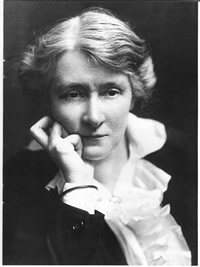 Edith Craig In 1932, when she was sixty-one, Marshall fell madly in love with Vita Sackville-West, a member of the Bloomsbury Group and a successful poet and writer. Their affair continued for several years and caused huge fights between Marshall and Craig. Atwood unsuccessfully tried to serve as a peacemaker.
In 1935, under her male name, Christopher St. John, Marshall wrote a biography of a distinguished physician, Dr. Christine Murrell, the first female member of the British Medical Association’s Central Council. Titled, “Christine Murrell, M.D., Her Life and Work,” St. John/Marshall wrote the dedication to both of Murrell’s lovers: Honor Bone, M. D. and Marie Lawson, a printer, editor, and tax resister. Like St. John/Marshall, Murrell had a threesome household.
Christabel Marshall/Christopher St. John died in 1960. She is buried next to Claire Atwood at St. John the Baptist’s Church, Small Hythe, England. This is the church where Dame Ellen Terry worshipped and where her funeral Mass was held in 1928. Edith Craig’s ashes were supposed to be buried there as well, but by the time of Marshall’s and Atwood’s deaths, they had been lost. A memorial was placed in the cemetery instead.
Why did so many Anglican clerics, creatives and/or socially prominent gays and lesbians convert to Catholicism in the Victorian and Edwardian eras? The Catholic Church has always been opposed to homosexual sex; but it also has been tolerant of gay sex among its members, including priests, the hierarchy and religious, as long as they were discreet and parroted official teaching in public. At that time, being Catholic was a little naughty, not socially acceptable, and showed a streak of rebellion and independence. Creatives were drawn to the sensuousness, the pageantry, and the mysteries in Catholicism. Catholicism emphasizes the body—the body of Christ in our mouth, the bodies of saints who give themselves up to pain and ecstasy, the homoerotic images found everywhere there are Catholic artists and cathedrals. For women, Catholicism offers many role models of women who lived full and fulfilling lives—without men.
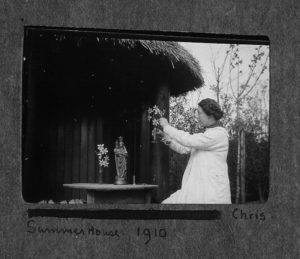 Christopher St. John’s Shrine
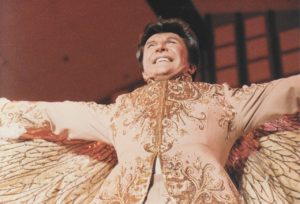
In 1959, the flamboyant entertainer, Liberace, sued the Daily Mirror, a British paper, for insinuating that he was a homosexual. Daily Mirror columnist, William Connor, writing under the pen name, Cassandra, described Liberace as “…the summit of sex – the pinnacle of masculine, feminine and neuter. Everything that he, she, and it can ever want…a deadly, winking, sniggering, snuggling, chromium-plated, scent-impregnated, luminous, quivering, giggling, fruit-flavoured, mincing, ice-covered heap of mother love.” In court, Liberace denied being a homosexual (“I’m against the practice because it offends convention and it offends society”) and sued for libel. He won and was awarded £ 8,000. Liberace skipped off and coined his famous saying, “I cried all the way to the bank.”
To the day of his death from AIDS in 1987, Liberace denied he was gay. He belonged to the generation of show business homosexuals (Rock Hudson, Tab Hunter, Anthony Perkins, Barbara Stanwyck, Katharine Hepburn, Agnes Moorehead..) who believed that their personal lives were private, and certainly not political. Liberace’s Catholic upbringing may have had a hand in shaping his attitudes, but so did social mores of post-World War II America. Actors and entertainers’ contracts included morals clauses. If they were exposed as homosexuals, their careers were over and they were economically ruined. “I don’t think entertainers should publicly air their sexual or political tastes,” said Liberace. “What they do in the privacy of their home or bed is nobody’s business.”
He encapsulates the institutional Catholic philosophy of homosexuality for both clergy and laity: flirt, enjoy romance, have sex with tricks and lovers, but always deny your homosexuality and condemn it in others. Above all, say nothing political. This practice was most recently on display with the outing and resignation of Monsignor Jeffrey Burrill, the general secretary of the U.S. Conference for Catholic Bishops in July 2021. Burrill was exposed through his cellphone data which indicated that he had repeatedly used his Grindr app to find men and had visited gay bars and bathhouses. 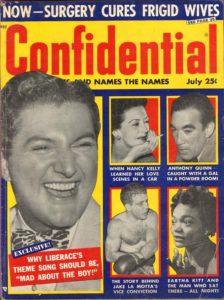
Wladziu Valentino Liberace (May 16, 1919-February 4, 1987) was the highest paid entertainer in the world at the height of his fame in the 1950s-1970s. Born in Wisconsin to parents of Italian and Polish origin, “Mr. Showmanship” was known for his excesses on the stage and off. After watching a movie about Frederic Chopin in 1945, Liberace made the candelabra his symbol, always on his piano during a performance. But he was best known for his elaborate, sensational costumes. There was a “King Neptune” costume; a red, white, and blue hot pants outfit; one of his favorites called the “lasagna” costume, which featured a cape that fanned out when he spun around. Two of the most “over the top” capes were designed by Liberace’s dear friend and furrier, Anna Nateece. One was white fox fur with a train 12 feet wide and 16 feet long. The second was made from 500 mink skins and weighed over 150 pounds. They were both trimmed with rhinestones.
His homes exhibited the same excess. Mirrored walls, a marble quarry’s worth of floors, colonnades and fixtures, a casino with a slot machine jackpot of three candelabras, a canopied bed with an ermine spread. On the bedroom ceiling was a reproduction of the Sistine Chapel with Liberace’s face among the cherubs. Liberace loved dogs and had about 20 of them between his Las Vegas and Palm Springs houses. They must have had a hard time skidding and slipping on the shiny marble floors.
Liberace was camp before the word came into wide-spread use. When the word first appeared in the early 20th century, it denoted “ostentatious, exaggerated, affected, theatrical, effeminate or homosexual behavior.” In the 1966 Batman television series with Adam West as Batman and Burt Ward is the Boy Wonder—the campiest show ever–Liberace played a dual role as a concert pianist, Chandell, and his gangster-like twin, Harry, who was extorting Chandell into a life of crime as “Fingers” in the episodes “The Devil’s Fingers” and “The Dead Ringers.” According to Joel Eisner’s The Official Batman Batbook,” they were the highest rated of all the show’s episodes. The show had huge homosexual overtones as well. Burt Ward speculated in his book, My Life in Tights, that Batman and Robin could have been lovers. What drew fans to Liberace was not only his flamboyant and outrageous costumes and act, but his warm, gracious, polite, and down-to-earth way of speaking to fans and his audience from the stage or television. “I talked to my viewers as if they were my friends, my next-door neighbors,” he said.
Liberace gave a hint to one of his connections to Catholicism when he once remarked on religion: “There will always be the need for people to worship,” he said, “whether it’s religion, an entertainer or a movie star. I’ve always felt close to religion because it’s a form of show business.” The late Bishop Fulton J. Sheen, Mother Angelica and even Bishop Robert Baron of Word on Fire could appreciate that statement. But when it comes to costumes, Liberace undoubtedly would feel closest to Cardinal Raymond Burke with his 20-foot train of watered silk, scarlet gloves, and jeweled red hats.
In November 1963, Liberace almost died from kidney failure during a performance in Monroeville, a town right outside of Pittsburgh, PA. The day before he had been cleaning his costumes in an unventilated room with a toxic cleaning solvent. The deadly fumes nearly killed him. He collapsed onstage and was rushed to St. Francis Hospital. Liberace was hooked up to a new device – a dialysis machine – and given a 20% chance of surviving. His doctors told him to get his affairs in order. “I took it very philosophically,” Liberace said. “I had led a good life, made a lot of people happy, and I had no regrets.” He described one experience during his hospital stay in his autobiography, The Wonderful Private World of Liberace that was a turning point in his recovery: “A very young and lovely nun wearing a white habit came to see me late one night, when I was very near death. She said that she was going to pray to Saint Anthony for me, and that he would make me well. The very next day, I began to get well. I described the nun to Mother Superior at the hospital and asked who she was. The Mother Superior said, ‘There are no nuns in the hospital who wear white habits.’” Dialysis took off after it saved Liberace’s life, and St. Francis Hospital gained a new, life-long patron. Liberace raised money for the hospital, financed a new intensive-care ward, and made sure that the sisters had tickets whenever he performed in Pittsburgh. 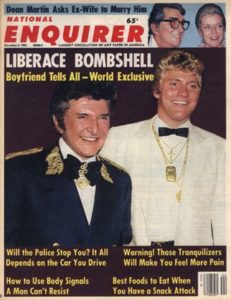
Soon after his Monroeville hospital stay Liberace was snared by sexual blackmailers. “The Chickens and the Bulls” extortion scheme is forgotten now, but it was a scandal in the mid-1960s. In a New York Times article published on March 3, 1966 – “Nationwide Ring Preying on Prominent Deviates,” a celebrity believed to be Liberace is described. “A TV celebrity, a twinkling star who has millions of female fans all over the world, refused to take the witness stand. However, he did tell investigators that he had paid blackmailers more than $20,000. “I can afford to lose the money,” he said, adding: “I hope they die of cancer.”
That incident didn’t slow Liberace down. He had affairs, tricks, and romances, taking in live-in lovers, usually blond, blue-eyed young men with strong physiques. One of his lovers, Scott Thorson, said Liberace’s first sexual encounter was with a Green Bay Packer football player. Thorson is also the source for a story of an affair between Liberace and Rock Hudson.
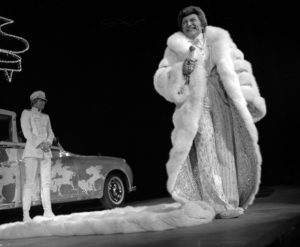 4/17/79
Liberace show at the Las Vegas Hilton Scott Thorson, 62, met Liberace in 1976 when he was 17. When he was 18, Liberace hired him to act as his personal friend and companion. He also incorporated Thorson into his Las Vegas performances. Thorson would don a chauffeur’s uniform covered in rhinestones and drive Liberace on stage in a Rolls Royce. The five-year relationship ended in 1982, when Liberace had members of his retinue forcibly eject Thorson from his Los Angeles penthouse. Thorson admitted that at least part of the reason for the breakup was his drug addiction.
But Scott Thorson wasn’t finished with Liberace. Shortly after he was dismissed/dumped, Thorson filed a $113 million dollar lawsuit against Liberace, the first same-sex palimony suit in U.S. history. Liberace continued to deny that he was a homosexual and insisted that Thorson was never his lover. The case was settled out of court in 1986, with Thorson receiving $75,000 in cash, three cars and three pet dogs. Thorson sniped that Liberace was a “boring guy” in real life, and mostly preferred to spend his leisure time cooking, decorating, and playing with his dogs.
In August 1985, Liberace was secretly diagnosed as HIV positive. Cary James Wyman, his alleged lover of seven years, was also HIV positive and died in 1987 at the age of 33. Another alleged lover, Chris Adler, came forward after Liberace’s death and claimed that Liberace had infected him with HIV. Adler died in 1990 at age 30. Besides his long-term manager, Seymour Heller, private physician, Dr. Ronald Daniels, and a few family members and close friends, Liberace kept his HIV positive status a secret until the day he died and did not seek any medical treatment for it. Urged by a former boyfriend to admit that he was sick, he refused, saying “I don’t want to be remembered as an old queen who died of AIDS.”
Liberace died on February 4, 1987 at The Cloisters, his home in Palm Springs, California. He was 67 years old. His death was initially attributed to anemia from a watermelon diet, and emphysema and heart disease from chain smoking. However, the Riverside County coroner performed an autopsy and while emphysema and coronary artery disease were present, the real cause was pneumonia due to complications from AIDS. Liberace received the Last Rites a few days before he died. “He had the rosary wrapped around his right hand. There was no jewelry. The rosary beads were his jewelry,” said his publicist, Jamie James.
Within hours of his death, his body was taken from his home directly to Forest Lawn Memorial Park in Los Angeles. He was buried on February 7th and is entombed with his mother and brother, George. The marble façade has the very enigmatic epitaph: “Sheltered Love.” A memorial service for Liberace had been held the day before at Our Lady of Solitude Church in Palm Springs. Two stars were present – a neighbor, actress Charlene Tilton from the television series, Dallas, and Kirk Douglas. There was a second memorial service at St. Anne’s Church in Las Vegas on February 12th, with Debbie Reynolds, Donald O’Connor, Robert Goulet, Rip Taylor and Sonny King in attendance. In contrast to his glittery public life, Liberace’s burial was private, and his memorial services were quiet and low key. 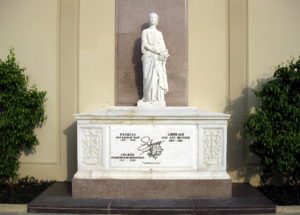
I agree with Liberace that not everyone is called—or should—make their private life public. Like most gays and lesbians of his era, he lied about or denied his homosexuality. That is an unadmirable trait, but understandable in the context of his time, his entertainment career and his faith. Except for a despised handful, there were no gay rights supporters, no “out” showbusiness people, religious, public figures, or academics until deaths from AIDS began in the 1980s and the gay and lesbian rights movement began to pick up momentum. His longtime publicist, Jamie James, once said, “He had this image, but he was no sissy. You have to be a pretty strong, brave person to wear what he wore and act like he did during those days. You had to have guts, believe me.”
Reading:
Liberace Cooks! – A Cookbook by Liberace. 1970
Liberace: An Autobiography by Liberace. 1973
The Wonderful Private World of Liberace by Liberace. 1986
Behind the Candelabra: My Life with Liberace by Scott Thorson. 1988.
Liberace: The True Story by Bob Thomas. 1988
Liberace: An American Boy by Darden Asbury Pyron. 2000
Rocking the Closet: How Little Richard, Johnnie Ray, Liberace and Johnny Mathis Queered Pop Music by Vincent L. Stephens. 2019
.
Chapter 1 – Meeting Ed Murphy
The story of Ed Murphy is fascinating, the way scandal, secrets, and evil are fascinating. It is a story with all the best ingredients—lust, betrayal, corruption, powerful men, redemption, and most of all—irony.
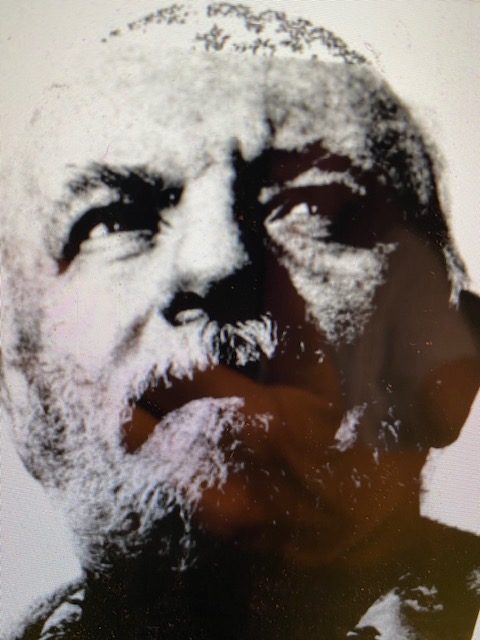 Ed Murphy, 1978 Ed “Skull” Murphy, a gay man who preyed on other gay men, was a secret informer for the FBI. He was protected by the FBI in return for the information he provided on Mafia operations and corruption in New York. He was also rumored to have photos of FBI director J. Edgar Hoover and other prominent government, business and entertainment figures having sex with male prostitutes. Ed Murphy ran prostitution rings of teenage boys and worked as a bouncer in gay bars. He was the doorman at the Stonewall bar the night of the famous raid on June 28, 1969. At that time, he did not identify himself as a gay man. He “came out” a decade later, at the end of the 1970s, when he said that he wanted to quit working for Mafia associates and stop informing for the police and FBI.
Ed reinvented himself as one of the heroes of the Stonewall raid. He continued to work in gay bars. He cultivated a tremendous visibility as the head of the Christopher Street Festival Committee, which organized the vendor booths/party/rally at the end of the annual Gay Pride Parade serving hundreds of thousands of people. Ed Murphy rode in a vintage Cadillac convertible near the head of the parade reserved for those who had been at Stonewall the night of the raid and riots on June 28, 1969. This date is now generally accepted as the beginning of the modern gay and lesbian rights movement.
I met Ed Murphy in the early 1980s when he was working in some bar in the Village, either Stonewall or One Potato, Two Potato. Ed was built like a brick house, stocky and solid, with a body that must have been all muscle in his youth. I was organizing the first group of Conference for Catholic Lesbians (CCL) marchers in New York’s Gay Pride Day parade. We also wanted to have a booth at the Christopher Street Festival in the Village for marchers to hang out after the parade. A booth on Christopher Street would also give us a great opportunity to hand out literature and meet and connect with other lesbians who had been raised Catholic. When I met him, Ed Murphy, or “Mr. Murphy” as I used to call him, was a leader in Heritage of Pride, the organization that ran the parade, festival, and dance in New York City. As such, he was the person to talk to about getting space. Ed always gave CCL table space right in front of St. Veronica’s Church.
“My sister is a nun,” he said to me. “Make sure you take good care of these girls,” he told the guy responsible for assigning spaces.
Our prime location paved the way for many women to find CCL. Ed Murphy always came by our table to make sure that we were fine, and everything was OK. That was my key impression of him: we were small and not influential on the gay scene, but Ed Murphy took care of us. That was also the impression of my friend and CCL co-worker, Barbara M. when she took over organizing the Pride Day booth.
“I remember the last time I had seen him; I was down on Christopher Street and found someone else setting up a booth in our space. I found out that Ed was sitting in a nearby bar, and I went in and found him without any trouble. He seemed to have a lot of adoring fans around him. I told him the story, and he sent out a couple of guys to straighten things out…I thought that they realized Ed was the authority, which prompted them to move, but they may have been afraid of him for all I know…I’d met Ed only three or four times and had short, congenial conversations with him. He was also middle aged by the time I met him. I found him very pleasant. I remember my last conversation with him was his concern that too many of the young fellas were still going bareback, and this was at the height of the AIDS crisis. He said much of the same sort of things I would say today: these kids think they’re immortal; you can’t make them see the seriousness of it because they don’t think it will happen to them. I was never sure if his calling me “Sister” had to do with the fact that I look like a nun or ex-nun…” said Barbara M.
When I met Ed Murphy, I was in my early 30s and he was about the same age as my father. They shared a similar upbringing and formation – the Great Depression and World War II. As boys they were poor, fast with their fists, and nonchalant about thievery. They grew up with no money – they stole to enjoy things their families could never buy. As men they could be gallant or menacing; fiercely protective or brutal. Ed referred to the police by the same name that my father did, “The Bulls.” Big guys with nightsticks that had no hesitancy about using them.
Ed spoke one night to a small group of lesbian and gay Catholics where we met on the Upper West Side in Manhattan. I was very moved to hear the story of his life and description of gay life in New York pre-Stonewall. Ed served time in jail. He stabbed another inmate in self-defense. Ed also made a point to say that he was proud that he didn’t rat people out to “the Bulls.” I had tears in my eyes at the end of his talk. He went through a lot of hell to help bring us to a place where we could live and love more freely. My last memory of him that night was seeing him standing under a streetlight saying goodbye. He looked like an old ex-fighter, scarred, and beaten up, but never a quitter.
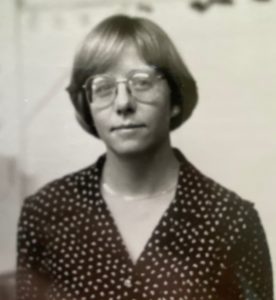 Karen Doherty, 1986 Imagine my shock when, 15 years later, I opened my Wall Street Journal to read an article by William McGowan, “Before Stonewall” which described a vicious extortion ring which targeted prominent and affluent closeted gay men. The gang was finally exposed and put out of business in 1966, but it ran for several years and netted over two million dollars. One of the major figures in this case was Edward “Mother” Murphy, a “ruthless West Side tough” who worked with a dozen other criminals in New York, Chicago, Washington, DC, Los Angeles, San Francisco, and a few other cities to blackmail men who picked up a male prostitute for sex during an out-town trip or when their family was away. “The Chickens and the Bulls,” as the case was known to the New York Police Department and District Attorney’s office, centered on “fairy shaking” or exposing men for their “homosexual proclivities” unless they paid well for it to be kept quiet. Over 1,000 men were victimized by the ring, including the head of the American Medical Association, two Army generals, a Navy admiral, several Hollywood celebrities, college professors and trustees and businessmen.
I relayed my discovery to my friend, Barbara M., who also met Ed Murphy, to hear her reaction. She said,
“To be frank, I’m having a tough time connecting the Ed Murphy I met with the “West Side tough” that he’s described as, or someone who would blackmail fellow gays,” she wrote. “This was in ’65. Ed Murphy was head of security in the Hilton Hotel, and when cornered he cooperated, which is probably why he got the light sentence. Although I think the basic person remains even as the body ages, men mellow. My theory is that the decreased testosterone is a good thing for some of them. Ed may have mellowed a lot and had a metanoia. He struck me as opinioned and forthright, but he didn’t act like a hoodlum. Nonetheless, he might have been. I was just a mere acquaintance; you knew him better. Can you picture that he was involved in this stuff? Maybe prison changed him. His sentence was rather light, and he didn’t serve the entire five years. Maybe he was an informant.”
Many years later, I am still trying to sort out my feelings about Ed Murphy. I knew him as a notable figure in the New York gay community in the 1980s. He was a kind, protective man to the less visible in the city–street kids, drag queens, and mentally challenged children. Ed was generous and caring to all those that he took under his wing, including my group of Catholic lesbians. I am appalled by the image of him as a leader and collaborator in a gay extortion ring, bullying sex and money from vulnerable men and teenagers. Ed Murphy combined prostitution, blackmail and strong-arm tactics into lucrative enterprises that ran for years.
He was also an informer, the worse type of person to anyone of Irish descent. It took the combination of a battery of Irish Catholic New York City Police detectives, the FBI, New York District Attorney Frank S. Hogan, and a federal prosecutor, Andrew J. Maloney, to finally knock him down. But it took the Stonewall raid, a beating by NYC police and a prison rape before he finally had enough and came out as a gay man and activist. That he ended up the Grand Marshall of the New York City Gay Pride Parade 23 years after his conviction for homosexual extortion is a story that boggles the imagination. Catholicism features stories of saints whose lives were full of depravity and evil but ended up redeemed through acts of virtue and heroism. Maybe that is Ed Murphy’s story, or maybe it is just the story he told himself and others.
Chapter 2: “Villainous Skull Murphy” will be posted tomorrow. You can read the whole article Ed_Murphy_Gay_Blackmailer_and_Activitist
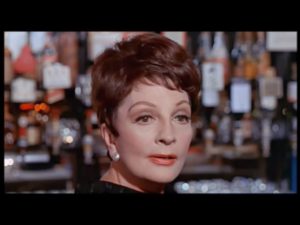 Coral Browne (July 23, 1913-May 29, 1991) was an accomplished stage and screen actress. She was also actor Vincent Price’s third wife. She was a woman who enjoyed a varied and robust sexual life. Browne portrayed no-nonsense BBC-executive, Mercy Croft, in The Killing of Sister George, a film depicting a lesbian love-triangle. She is perfect as a smooth, predatory seductress—a role in which she had plenty of experience. Coral Browne (July 23, 1913-May 29, 1991) was an accomplished stage and screen actress. She was also actor Vincent Price’s third wife. She was a woman who enjoyed a varied and robust sexual life. Browne portrayed no-nonsense BBC-executive, Mercy Croft, in The Killing of Sister George, a film depicting a lesbian love-triangle. She is perfect as a smooth, predatory seductress—a role in which she had plenty of experience.
Coral Browne converted to Catholicism shortly after World War II and remained a devout Catholic throughout her life. As a gift to her, Vincent Price converted to Catholicism. Her friend, Noel Davis, described the melding of her personality and faith: “I’m a Catholic of a sort, and I was always amused by her Catholicism because she was much more devout than fitted in with her obscenities. She never missed Mass on Sunday.” Existing the Brompton Oratory one Sunday morning, salty-tongued Browne was accosted by a theater friend with the latest gossip. She stopped him midsentence, exclaiming: “I don’t want to hear such filth, not with me standing here in a state of fucking grace.”
Browne did not get along with Vincent Price’s daughter, Victoria Price, but they both shared an interest in women. “Coral lent a sympathetic ear to my romantic troubles. Both were eager to meet anyone I brought home, though my stepmother rarely missed an opportunity to flirt outrageously with my girlfriends or to comment on their looks and style. One woman, she told me with a very knowing smile, “does it very well.” I took that as some kind of compliment.” Coral also told Victoria Price about a five-year relationship she had with a woman. Its dissolution was, according to Browne, the most heart-breaking moment of her life. 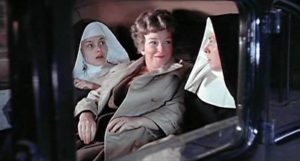
In The Killing of Sister George (1968), BBC executive Mercy Croft (Coral Browne) is sent to chastise Sister George/June Buckridge (Beryl Reid) for a drunken incident involving two nuns. Buckridge is a middle-aged soap opera actress, and Alice “Childie” McNaught (Susannah York), her lover, has a minor fashion industry job, writes poetry and collects dolls. George/June is often verbally and physically abusive to Alice, and her treatment of her becomes worse as her character is scheduled to be eliminated on the popular show. The movie was given an “X” rating because of a two-minute masturbation scene between Coral Browne (Mercy Croft) and Susannah York (Alice “Childie” McNaught). The scene was panned as cold and unsexy—probably because they had most of their clothes on and didn’t writhe and moan continuously. But in 1968 it was revolutionary to see two mature women–McNaught was in her 30s and Croft was in her 50s–having sex to orgasm in a movie.
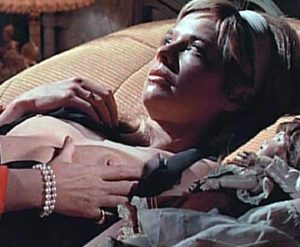
The movie was also history-making in that the director used a real lesbian bar for the lesbian club scene. Between June 9-16, 1968, The Killing of Sister George was shot at the Gateways, a lesbian club that operated in London between 1931 and 1985. Forty members were used as extras, one of whom lost her job when her employer recognized her in a publicity still. George and Alice go to an event at Gateways to which George jokingly invites Mrs. Croft. Mrs. Croft arrives to tell June in person that Sister George will die by being hit by a ten-ton lorry, eliminating her from the show. After June storms out, Mrs. Croft invites Alice to meet with her to further discuss her poetry. Alice has found a new lover/provider and June blew her chance with a woman she once desired and adored.
I wonder how Coral Browne reconciled the sexual and religious aspects of her life. She doesn’t strike me as a hypocrite and didn’t feel obligated to “leave” the Church. Browne died in 1991 without expressing a public opinion or statement; so we’ll never know her thoughts and feelings. The one aspect we do know is that she appeared to value monogamy while married. She had Vincent Price give up a male friend to whom he was strongly attached. That hurt Price deeply. It’s my one mark against Coral Browne.
How do you remain as lesbian and Catholic? My stance—perhaps Coral Browne’s—is to embrace the beautiful and positive in both and dismiss the negativity from secular skeptics and religious gatekeepers. The focus on what is most important – our relationship with God – can be difficult to achieve with all the worldly chatter and distractions; but over time we can sustain it through prayer, quiet time, meditation and the Eucharist.
Click here to see a trailer of The Killing of Sister George.
Click here to see a YouTube video of the Gateways club scene in the film.
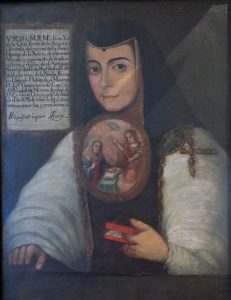
Sor Juana Ines de la Cruz (November 12, 1648 – April 17, 1695), was passionate about educational access, books, learning, equality and women. She was a 17th century nun, self-taught scholar and acclaimed writer. She was born in San Miguel Nepantla near Mexico City on November 12, 1648. Her parents were Isabel Ramirez, a Criolla (native-born Spanish) woman, and Captain Pedro Manuel de Asbaje of Spain. They didn’t marry. Juana lived a comfortable life on the estate of her maternal grandfather. She educated herself in her grandfather’s library. Juana was a high-spirited girl who loved learning and the life of the mind. She was also very beautiful to which her portraits will attest. She was fluent in Spanish, Nahuatl and Latin.
When she was 16 she asked for her parents’ permission to disguise herself as a youth to attend the university, which did not accept women. Her family sent her to court to meet influential people and find a husband. Instead, in 1669, she entered the monastery of the Hieronymite nuns. She choose to become a nun “to have no fixed occupation which might curtail my freedom to study.”
As a nun, she was free to study the 4,000 books she collected, mostly from her grandfather’s library. Her cell became a salon for the intellectual elite. She gained the patronage of the viceroy, Marquis de la Laguna, and the vicereine of New Spain, Countess Maria Luisa de Paredes. They supported and protected her, and had her works published in Spain. The two women became passionate friends. Whether or not a physical relationship existed isn’t clear, but love and desire definitely existed. In her poem, “My Lady” Sor Juana Inez describes her emotions: 
“I love you with so much passion, neither rudeness nor neglect can explain why I tied my tongue, yet left my heart unchecked.
The matter for me was simple; love for you was so strong, I could see you in my soul and talk to you all day long.
How unwisely my ardent love, which your glorious sun inflamed, sought to feed upon your brightness, though the risk of your fire was plain!
Let my love be ever doomed if guilty in its intent, for loving you is a crime of which I will never repent.”
Sor Juana’s sermons, which were transcribed and widely circulated, paid unusual attention to gender imagery. She said that she had been conceived as a male but was changed in utero by God to become female. She delighted in Jesus’ self-reference as a mother hen and spoke of the male and female aspects of God. She believed this mixture of identities also resided in the human soul:
“And all those who seek in me a father,” she wrote, “will find me a father. And those who seek in me a mother, will find in me a mother. And those who seek in me a husband, will find in me a husband. And those who seek in me a bride, will find a bride. And those who seek in me a brother, or a friend, or a neighbor, or a companion, likewise will find in me everything they desire.”
In 1692, Church authorities cracked down on Sr. Juana, not because of gossip or lesbian love poetry, but because she openly challenged societal and ecclesiastical values and norms on women. In her most famous work “Respuesta a Sor Filotea” she defends women’s rights to educational access and opportunity to serve as intellectual authorities. Sor Juana argued that women could educate other women.
Threatened by the Inquisition, Sor Juana was silenced for the final three years of her life. There are documents showing her agreeing to undergo penance. One such document is signed, “Yo, la Peor de Todas” (I, the Worst of all Women”). Her books, scientific and musical instruments were confiscated and sold. Sor Juana died three years later nursing her sister nuns during a cholera epidemic. She was 46. Sor Juana is buried in the site of her former convent, San Jeronimo, at the University of the Cloister of Sor Juana in Mexico City.
Sor Juana lay in oblivion for several hundred years until Phoenix-like she sprang into life. Two of the sparks were books and research done by writers Octavio Paz of Mexico and Dorothy Schons of the University of Texas. 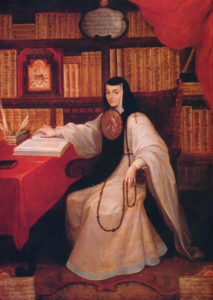
The relationship between Sor Juana and Countess Maria Luisa is explored in “Sor Juana’s Second Dream” a book published in 1999 by Dr. Alicia Gaspar de Alba. She also writes about Sor Juana in “(Un)framing the Bad Woman: Sor Juana, Malinche, Coyolxauqui and Other Rebels with a Cause,” published in 2014. A series of photos inspired by Sor Juana’s life and passions was created by Alma Lopez in 2019. Gaspar de Alba and Lopez, married to each other since 2008, have also explored lesbian connections with Our Lady of Guadalupe.
Maria Luisa Bemberg, one of Latin America’s foremost female directors, imagines the love between Juana and Maria Luisa in the 1990 film, “I, the Worst of All.” The film was Argentina’s entry for Best Foreign Language Film that year.
How far did the passions of Sor Juana go? My feeling is that she had an unbridled imagination, a tormented yearning and a chaste life. I’m sure she shared some tender, passionate, embraces with Maria Luisa, but a lack of time, privacy and mutual restraint kept a lid on any other expressions. But what a kiss it must have been!
 Mosaic at the entrance to St. Michael’s Church In Neil Simon’s 1976 comedy mystery film, Murder by Death, the character Sam Diamond, a parody of the fictional detective, Sam Spade, is played by Peter Falk. His secretary (and girlfriend) blows his cover as a straight, tough guy when she tells the other detectives and guests that Diamond keeps stacks of naked muscle man magazines in his office. Diamond counters that they are part of his detective work –“I’m always looking for suspects!” he says. “I hate them queeries!”
The Rev. George William Rutler, 75, hates queeries, too, but must he have needed new material for an article, Eternal World Television Network (EWTN) program, or one of his pounding homilies. On November 4, 2020, he was caught watching gay porn on the rectory TV by Ashley Gonzalez, 22, a security guard, who filmed a 19-second clip of a man who looks like Father Rutler watching two men blow each other. Gonzalez said she started filming after she heard “sexual noises” on the TV and saw the priest masturbating. Rutler had initially watched election coverage but switched it off around 1:30 am to something more edifying. I think at that point, Joe Biden had beaten Donald Trump for the presidency.
Rev. George William Rutler is one of the most famous conservative priests in the U.S., and a long-time critic of Pope Francis, Democratic politicians and “sodomites.” According to Rod Dreher of the American Conservative, Rutler “presents himself as a flinty arch-conversative who suffers no fools gladly.” He is quite explicit on his view of sex: “The only safe sex is real sex, done for the procreation of life and the sanctification of love.” 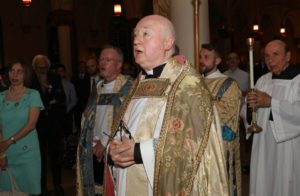
When Gonzalez tried to flee the room, Fr. Rutler grabbed her. “He aggressively threw himself on me and grabbed me sexually, aggressively, and I was fighting him off of me,” Gonzalez told News 12, who added that she sent frantic text messages to her mother begging for help. Gonzalez, who is about five feet tall, got out of the office by elbowing the old geezer in the chest. She made it to the street and called a private detective.
There are a number of weird things in Gonzalez’ story: why would a man who is getting off on two guys having sex try to grope or force himself on a woman? And, how can you possibly have time or your hands free to text your mother if someone is trying to rape or molest you?

What seems unequivocal thanks to a cell phone video clip is that Rev. Rutler’s career as a conservative Catholic spokesman and as a liberal and gay basher is washed up. Even though the assault accusation could be a “he said, she said” situation, the video evidence, and the downloads and browser history on the rectory computer will not lie. Rutler has stepped down as pastor of the Church of Saint Michael Church in Manhattan and has been dropped by EWTN.
One of Fr. Rutler’s quotes on homosexual activity sums up his downfall perfectly: “If people want to engage in aberrant sexual activities, well, by all means then they are free to do so. They are free to pay the penalty.”
P.S. To the Episcopal Church: STOP sending us your self-loathing, hypocritical homosexual priests! We have enough of our own.
|


































